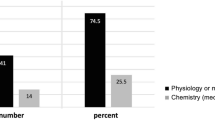Abstract
In the long history of traditional Chinese medicine (TCM), meridians play essential roles as the critical network to regulate the normal physiological functions of the human body. They are regarded to be the channels connecting the internal organs with the body surface and various parts of the body. Although there are many studies and doctrines trying to reveal the nature of meridians for their validation in TCM, the mechanism underlying the meridians remains unclear. Herein, based on our macroscopic quantum state concept of ion channels (i.e., sub-nanometer scale channels), we propose a quantum principle of meridians. The acupoints and organ symptom are in a macroscopic coherence state of the ion channels in meridians. By applying TCM treatments (e.g., TCM massage, acupuncture, moxibustion, and electroacupuncture) on the acupoint, the corresponding organ symptom could be well regulated with help of quantum meridian state.

Similar content being viewed by others
References
Chen, X. N. Chinese Acupuncture and Moxibustion; Foreign Languages Press: Beijing, 2003.
Helms, J. M. Acupuncture Energetics: A Clinical Approach for Physicians. Thieme Publishers: Berkeley, 1995.
Xia, Y. Advanced Acupuncture Research: From Bench to Bedside; Springer: Cham, 2022.
Xue, C. C. L.; Zhang, A. L.; Greenwood, K. M.; Lin, V.; Story, D. F. Traditional Chinese medicine: An update on clinical evidence. J. Altern. Complement. Med. 2010, 16, 301–312.
Zhu, Z. X. The advances and prospect in physiological and biophysical approaches of acupuncture meridian system. Acupunct. Res. 1988, 13, 81–89.
Wang, G. J.; Ayati, M. H.; Zhang, W. B. Meridian studies in China: A systematic review. J. Acupunct. Meridian Stud. 2010, 3, 1–9.
Yang, M. N.; Han, J. X. Review and analysis on the meridian research of China over the past sixty years. Chin. J. Integr. Med. 2015, 21, 394–400.
Schröder, S.; Liepert, J.; Remppis, A.; Greten, J. H. Acupuncture treatment improves nerve conduction in peripheral neuropathy. Eur. J. Neurol. 2007, 14, 276–281.
Longhurst, J. C. Defining meridians: A modern basis of understanding. J. Acupunct. Meridian Stud. 2010, 3, 67–74
Ding, G. H.; Yang, J.; Chen, E. Y.; Shen, X. Y.; Dang, R. S.; Yao, W.; Cheng, H. S.; Liu, F.; Fei, L. Directional flow of human tissue fluid and meridian. Prog. Nat. Sci. 2001, 11, 811–818.
Bai, Y.; Yuan, L.; Huang, Y.; Wu, J. P.; Wang, J.; Dai, J. X.; Wang, C. L.; Jiang, X. M.; Li, D. F.; Yang, C. et al. Anatomical discovery of meridians and collaterals lead to the new theory of fasciaology. World Sci. Technol. Modern. Trad. Chin. Med. 2010, 12, 20–24.
Wang, C. L.; Wu, J. P.; Wang, J.; Yuan, L. An interpretation on the essence of meridians and acupuncture mechanism from fasciaology view. Chin. J. Basic Med. Tradit. Chin. Med. 2008, 14, 312–314.
Zhang, C. L. Relationship of electron-magnetic standing wave with acupuncture meridian. Acupunct. Res. 1995, 20, 52–62.
Lin, X. Z.; Xiao, Y. Mechanism underlying the formation of the propagated sensation along meridians (PSM) in Human body. J. Yunnan Coll. Tradit. Chin, Med. 1995, 18, 32–38.
Brizhik, L.; Chiappini, E.; Stefanini, P.; Vitiello, G. Modeling meridians within the quantum field theory. J. Acupunt. Meridian Stud. 2019, 12, 29–36.
Liu, S. B.; Wang, Z. F.; Su, Y. S.; Qi, L.; Yang, W.; Fu, M. Z.; Jing, X. H.; Wang, Y. Q.; Ma, Q. F. A neuroanatomical basis for electroacupuncture to drive the vagal-adrenal axis. Nature 2021, 598, 641–645.
Guo, Y.; Chen, S. B.; Zhang, C. X.; Wang, X. Y.; Miao, W. F.; Shi, L. P.; Zhang, G. Z. Specific distribution of Ca2+ concentration in acupoints of healthy human bodies. Shanghai J. Acupunct. Moxibust. 2002, 21, 37–38.
Wen, L. P.; Zhang, X. Q.; Tian, Y.; Jiang, L. Quantum-confined superfluid: From nature to artificial. Sci. China Mater. 2018, 61, 1027–1032.
Song, B.; Jiang, L. The macroscopic quantum state of ion channels: A carrier of neural information. Sci. China Mater. 2021, 64, 2572–2579.
Deadman, P.; Al-Khafaji, M.; Baker, K. A Manual of Acupuncture; Journal of Chinese Medicine Publications: Hove, 1998.
Lin, Y. C.; Hsu, E. S. Z. Acupuncture for Pain Management; Springer: New York, 2014.
Guo, X. Q.; Jia, R. J.; Cao, Q. Y.; Guo, Z. D.; Li, P. Inhibitory effect of somatic nerve afferent impulses on the extrasystole induced by hypothalamic stimulation. Acta Physiol. Sin. 1981, 33, 343–350.
Ozaki, Y. Infrared spectroscopy-mid-infrared, near-infrared, and far-infrared/terahertz spectroscopy. Anal. Sci. 2021, 37, 1193–1212.
An, N.; Cao, F. Z.; Li, W.; Wang, W. L.; Xu, W. N.; Wang, C. H.; Xiang, M.; Gao, Y.; Sui, B. B.; Liang, A. M. et al. Imaging somatosensory cortex responses measured by OPM-MEG: Variational free energy-based spatial smoothing estimation approach. iScience 2022, 25, 103752.
Li, P.; Cheng, L.; Liu, D. M.; Painovich, J.; Vinjanury, S.; Tjen-Alooi, S.; Longhurst, J. Long-lasting inhibitory effect of electroacupuncture in hypertensive patients ő role of catecholamine, renin, and angiotension (1140.3). FASEB J. 2014, 28, 1140.3.
Dietzel, J.; Eck, T.; Usichenko, T. Treating therapy-resistant headache after aneurysmal subarachnoid hemorrhage with acupuncture. Neurocrit. Care 2019, 31, 434–438.
Liu, Y. W.; Kuo, C. W.; Chang, T. C.; Hung, Y. C.; Tan, Y. F.; Wu, C. C.; Lin, C. H.; Chen, W. C.; Hu, W. L.; Tsai, T. M. Analysis of meridian flow direction by electrical stimulation method. Nanoscale Res. Lett. 2022, 17, 64.
David Lytle, C.; Thomas, B. M.; Gordon, E. A.; Krauthamer, V. Electrostimulators for acupuncture: Safety issues. J. Altern. Complement. Med. 2000, 6, 37–44.
Acknowledgements
This work was supported by the National Natural Science Foundation of China (Nos. 21988102, 22122207, T224100002, and 62101017), the National Key R&D Program of China (No. 2021YFA1200404), the Innovation Program for Quantum Science and Technology (No. 2021ZD0300500), and the Development and Application of Ultra-Weak Magnetic Measurement Technology based on Atomic Magnetometer (No. 2022-189-181).
Author information
Authors and Affiliations
Corresponding authors
Rights and permissions
About this article
Cite this article
Kong, XY., Xiang, M., Fang, J. et al. The connection between meridians and physiological functions: A quantum principle. Nano Res. 16, 12817–12820 (2023). https://doi.org/10.1007/s12274-023-6203-z
Received:
Revised:
Accepted:
Published:
Issue Date:
DOI: https://doi.org/10.1007/s12274-023-6203-z




